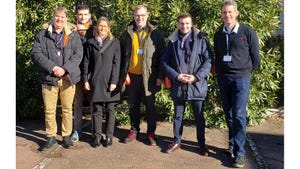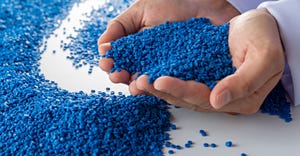IMM Plant Tour: Keeping the world in gear
August 4, 1998
Axxicon Components Rochester Inc.
just officially opened the doors of its new facility in West Henrietta, NY on April 3. It is a sister company of Axxicon Components Vianen BV of the Netherlands, and both belong to the Netherlands-based Axxicon Group of companies, listed on the Amsterdam stock exchange. Why did this Dutch molder transplant itself into the suburbs of Rochester, NY? One company official jokes, "Well, we are not really custom molders, but we do have customers."
Axxicon Components prides itself on being responsive to its customers, customers like U.S.-based multinationals with global products who have availed themselves of Axxicon Component's specialties--big multinational customers like Xerox, which, coincidentally, happens to be based in the Rochester area. These customers asked Axxicon Components to locate closer to them so that they could have access to the company's specialties more easily and earlier on in their product development efforts. That's because these companies were unable to find Axxicon Components' specialties anywhere else in the world, specialties like the engineering, production, and JIT delivery of some very special parts.
Every year the document processing and automotive industries are developing more advanced products and subsystems for the world market, while seeking to establish harmonized worldwide standards. Both of these markets require high-performance gears, pulleys, helixes, and other high-precision components. Such components are Axxicon Components' specialties, and, for many of them, Axxicon benefits from single sourcing. It wants to grow its business by following its customers. West Henrietta is its first stop.
You're right in thinking that it takes a special kind of operation to mold special products like high-precision gears, products so special to its customers that they would ask a supplier to move next door. So, before we take a look at the special products Axxicon Components Rochester molds, let's recreate the opening ceremonies in April, and see where the parts are molded. Let's tour.
Designed For Expansion
After pausing to admire the amazing display of parts in the lobby's showcase, we shake hands with the company's three top officials, here for the opening ceremonies: Bernard Doorenbos, president of the Axxicon Group; Jeroen Jonker, recently promoted to the managing directorship of Axxicon Components Vianen; and Maarten van Mourik, managing
director of Axxicon Components Rochester (ACR).
As we are ushered through the administrative office area to the shop floor, stopping for a moment to play with the office area's energy-saving motion-detection lighting system, Jonker explains that ACR eventually will be a replica of his plant in the Netherlands. Customers in North America will be assured of the same high quality, delivery, and service that has built the company's reputation for excellence overseas. Still, Jonker admits to having mixed emotions, "I am proud of my company, but I am also jealous of this new building."
He goes on to say that the European organization will support the Rochester facility in the early going, but that ACR will be made autonomous in a very short amount of time. "We have a tremendous opportunity to develop global projects for world customers with our facilities on both sides of the Atlantic," Jonker says. "World-class products for the world market." As we enter the immaculate but seemingly empty plant floor, Axxicon Group's Doorenbos is finishing his opening remarks, explaining how Axxicon Components already accounts for 25 percent of the total group's sales. That figure may increase 10 percent or more because of ACR.
We're standing on the side, admiring the plant's 26-ft high ceiling, lit by bright metal halite lighting, when van Mourik warns us, "Don't lean too hard on the walls. This place is built for quick expansion." Its existing 23,000 sq ft of floorspace could quickly and easily be tripled, though up to 12 molding machines could fit into the existing floorspace. Expansion up to 30 machines at some point in time is envisioned. There's a mezzanine above an area of offices and quality assurance near the entrance that is designed for the installation of windows and conversion to office space. We're mentally calculating the expense of the stone-hard epoxy-over-masonry finish of the reinforced flooring when we hear the two anthems being played, the sound of champagne corks popping, and the scissors slicing the ribbon.
We walk underneath the two-ton crane that traverses the length of the plant, following it to the molding machine area underneath. There are just three machines in the plant so far, three tiebarless Engels, an Axxicon standard, but they look a little different. We're told that they are from Engel Austria, and that they have been custom-built to Axxicon's proprietary specifications. Each is equipped with Engel's top-of-the-line CC-100 total closed loop control system and robots from Engel Automation. Axxicon Components does robotic insert molding in the Netherlands, and some overmolding as well; ACR will replicate these processes. Production eventually will be fully automated.
There are no cardboard boxes around the machines. Only plastic containers are used. Axxicon has standardized on counting/indexing parts conveying systems from TEC Engineering, and HB Therm mold temperature controllers. Materials handling systems are from Motan and Dri-Air. Our attention also is drawn to the well thought out modular design of the overhead frame for the machine utility drops, which feature walkways. It can be expanded to accommodate more machines as easily as the entire plant.
Tooling
We're told that ACR can run its customers' tooling, but that it mostly runs its own. There's no moldmaking room though. Its tools are shelved in the plant's mold maintenance and repair room, where an Atlas lathe and a Clausing Industrial milling machine have already been installed. But there's no moldmaking equipment. Not here, anyway.
With manufacturing facilities and offices in four countries, including Atlanta, GA, Axxicon Molds is one of the world's leading specialty moldmakers.
One out of every three CDs in the world is molded in Axxicon tooling, for instance. It also designs, engineers, and builds tight-tolerance, high-volume tooling for other advanced data storage media, such as DVDs, MDs, CD-Rs, CD-MOs, and smartcards. And it has established quite a portfolio of high-precision modular mold systems, ranging from its Standardized High Volume Molds and Quick Change tooling to its AIM and Rapid Release mold systems, all of which have been reported on during the years in IMM.
As we are admiring the craftsmanship of the tooling on the shelves, ACR's van Mourik, who is also in charge of Axxicon's molds in the States, tells us that ACR provides comprehensive engineering, moldmaking, and assembly support, as well as molding and delivery of its molded components. This will ensure that projects are finalized to its customers' tight deadlines and exacting specs. Global support is provided for global projects.
High-precision Components
"We don't want to become just another one of the 60 or so molders in this area," Jonker says. ACR will specialize in manufacturing functional parts like gears, pulleys, helixes, and other precision parts for printers, fax machines, and photocopiers in the document processing market. It will also supply similar parts to Tier Ones for automotive electromechanical subsystems.
The gears it molds for document processing equipment are used in fuser rollers, photoreceptor drums, and processors. They comply with all major quality specs like ISO, AGMA, DIN, and JIS, with dimensions ranging from .01 to .1 inch (.3 to 2.5 mm). ACR uses wear and heat-resistant--up to 570F (300C)--engineering materials. Worm, spur, and bevel gears with straight or helical toothing having tolerances in some cases down to 3 µm are what the company does best. They can be provided with special profiles to reduce running noise. High-volume automotive gear production, including gear insert molding, will be robotized.
ACR's helixes for precision headprinter drives and toner transport units used in printers, fax machines, and copiers, are engineered to be free of parting lines through the application of Axxicon Mold's proprietary tooling technology. Helix lengths up to 24 inches (600 mm) have been produced overseas, for metal replacement, and for overmolding metal shafts.
ACR will produce all of the popular pulley profiles and custom profiles, as well. Again, the company's top-secret technology, developed with more than 30 years of experience, ensures minimum wear and optimum running-noise reduction.
Its automotive pulleys are designed for thermal stability, extremely good run-out characteristics, and equally excellent dimensional stability. Lighter and less expensive than steel, its pulleys are for front-end and synchronous engine drives. Filled or unfilled high-performance resins are molded into parts for service environments ranging from -20F to 340F (-30C to 170C).
Stripper fingers, precision components that peel off paper from a drum, are an Axxicon Components specialty. They rank among the most critical and delicate plastic parts found in printers, fax machines, and copiers. Dimensionally stable perfection is required to lower finger-to-drum friction, and to reduce the risk of paper jams. ACR will mold them from PAI, PI, and PAEK, and they can be delivered with PTFE coatings for heat resistance .
The opening ceremony celebration is winding down, so we'd better leave. The folks at ACR are eager to get to work. After all, anxious multinationals are waiting right outside their door.
Square footage: | 23,000 |
Markets served: | Document processing, automotive |
Parts produced: | Precision gears, pulleys, helixes, stripper fingers |
Average annual sales: | $50 million (total, Axxicon Group),$12.5 million (Axxicon Components) |
Initial capital investment: | $2.5 million |
Materials processed: | Filled (glass, carbon, PTFE, silicone) and unfilled POM, PA, PES, PBT, PPS, PC, LCP, PAI, PI, PAEK, and specialty compounds |
No. of employees: | Five (25 when molding machine capacity is reached |
Shifts worked: | Three shifts, six to seven days (eventually) |
Molding machines: | Three Engels, 25-, 75-, and 150-ton (existing capacity for 12 machines) |
Secondary operations: | Welding, postbaking, manual assembly |
Internal moldmaking: | No |
You May Also Like


